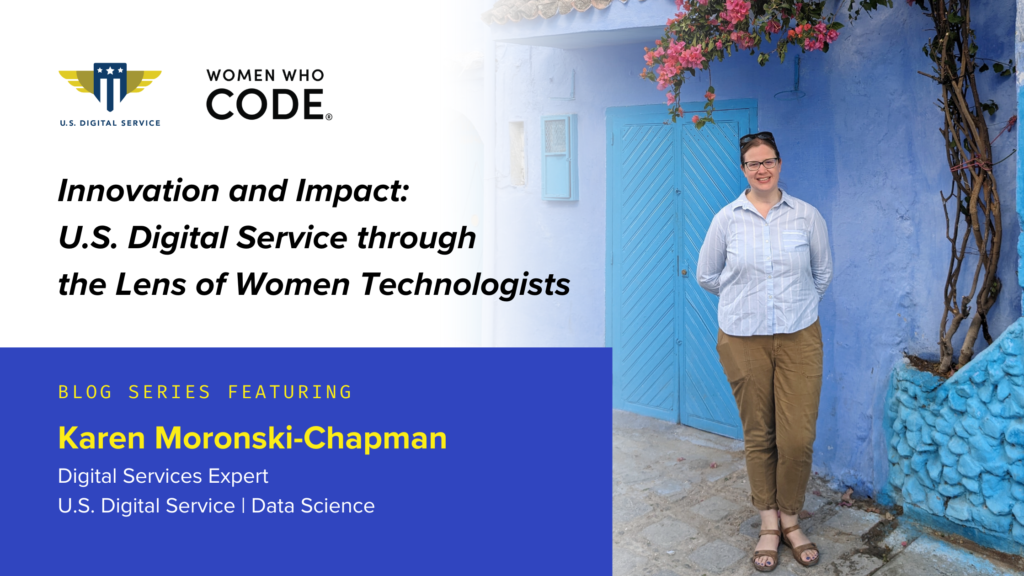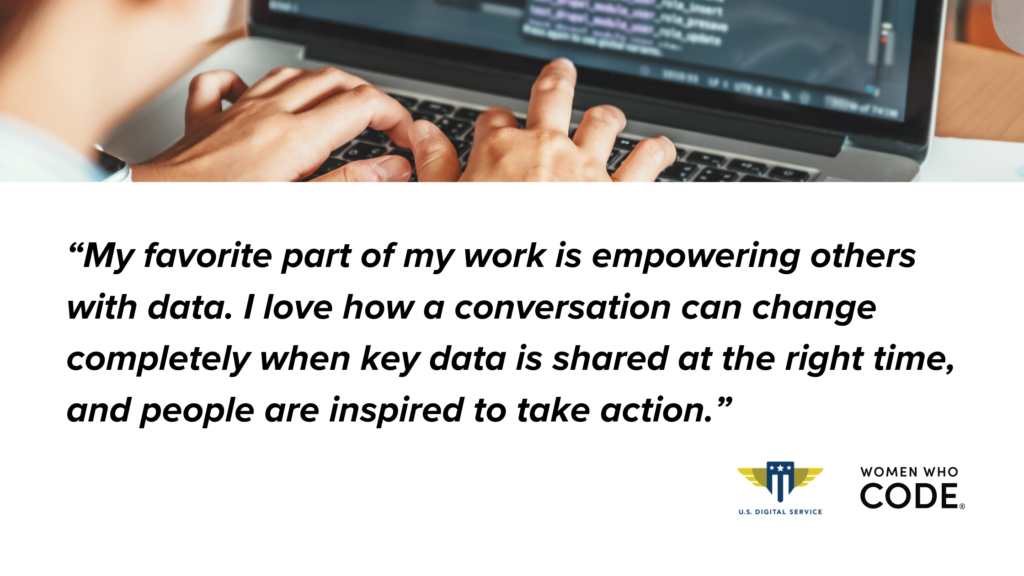Innovation and Impact: U.S. Digital Service Through the Lens of Women Technologists | Karen Moronski-Chapman
Written by Women Who Code

In this monthly blog series, Innovation and Impact: U.S. Digital Service through the Lens of Women Technologists, we spotlight some phenomenal women technologists at the forefront of transforming the U.S. Digital Services (USDS) — the government’s digital agency for technology and innovation. They share their expertise, leadership insight, and impact on shaping the nation’s digital landscape, representing diverse software engineers, data scientists, product managers, and UX designers who drive innovation within the U.S. government.
Each blog delves into their unique journeys, career paths, challenges faced, and the pivotal projects they’ve undertaken, and share insights into the dynamic intersection of technology and public service.
Karen Moronski-Chapman is a Data Scientist at U.S. Digital Services (USDS), where she’s worked on data problems at various agencies. She loves using data to help people think differently about what is possible.
Can you tell us more about your career journey and non-traditional career path?
I don’t feel like I chose to be a data scientist; it chose me! I have always been a numbers person; that tendency and my Bachelor of Mathematics degree have led me on an interesting path. Today, if you ask me where I still want to go in my career journey, I wouldn’t be able to answer because it is still changing, and there are so many possibilities! I was still undecided about post-graduation, so I did temporary work for a couple of years. At the time, it made me feel like a failure for not getting a permanent job like my friends, but in hindsight, it was the perfect way to try out several different career paths quickly. Later, I decided to get a Master’s in Higher Education Administration as it was a requirement for a job I wanted, and I always liked school, so why not? I fell in love with research and listened to my advisor when she said I should pursue a doctorate. Higher Education Public Policy is the perfect field for someone with relentless curiosity. And it is a blend of many subjects I love: economics, statistics, psychology, and sociology.
Fast forward a few years and countless statistics and research methodology courses later, I was recruited by a former mentor to work as a program assistant on a Department of Education Title III grant for a university. The grant focused on helping underrepresented students succeed in STEM fields, which I was passionate about. In this role, I could work on various things, collaborate with an amazing team, and be inspired by the students we worked with. It didn’t take long before hearing, “You’re really good at this data thing, so we’re going to have you do more of that.”
After a few years, I became that university’s director of institutional research (IR). I loved my years working at a university with and for students. The impact was tangible and immeasurable, and my conversations with students were priceless. While in my director of IR role, I was sponsored for an experiential leadership program called Leadership Buffalo. There, I learned firsthand about the issues faced by my community and about servant leadership. If your community has a program like this, I highly recommend the experience!
Coincidentally, this is also where a new trajectory in my career emerged when a classmate one day asked me, “You do data stuff, right?” They had a lot of data and weren’t quite sure what to do with it and a set of problems they hoped to solve quickly. This allowed me to transition into a role as director of research, strategy, and analytics at a media company, and the opportunity took me out of my comfort zone of subject matter expertise and allowed me to level up quickly in so many new areas. I’m not going to lie; leaving a field in which I had two graduate degrees was not easy, but I don’t regret it.
I was involved in data or numbers-heavy work for a while, but my title was never “data scientist,” and, truthfully, I did not identify as one. I had a narrow range of what a data scientist did within the realm of “data things” and felt like I didn’t fall into that range until I met a U.S. Digital Service (USDS) employee who convinced me that I did fit and I should apply to work with them. For the past year, I’ve had the formal title of data scientist while at U.S. Digital Service, and I have created an identity out of the broad data science spectrum that I like to call the “people side of data science.”
What are the key aspects of your work at USDS? How have you been able to define your work?
I often describe working at the U.S. Digital Service as a bit of a “choose your own adventure” since we have so many interesting projects that one can express interest in being a part of. At USDS, data scientists, engineers, product managers, and other experts partner with different federal agencies to implement government programs for the American public. Every project is different, and I get to apply my data expertise somewhat differently on each project. So far, I am developing quite the USDS bucket list, and it will be challenging to check everything off during my term. One of the best parts about my job is the people; they are some of the most talented yet humble and kind people I have ever met.
What is the impact of the work you and your team do?
I’m on a project with the Centers for Disease Control and Prevention (CDC) with the newly formed Office of Public Health Data, Surveillance, and Technology. The CDC and USDS are taking a human-centered design approach to support initiatives as part of the CDC Public Health Data Strategy. This work will help the nation become more pandemic response-ready, promote health equity, and improve health outcomes for all.
How can you make data more meaningful and manageable in your day-to-day work?
This is one crucial element of the people side of data science. One makes data meaningful by asking the right questions and being a good listener. Data is also more likely to be meaningful if it is actionable and timely. Manageable data is all about sustainability. In other words, does the value of the data outweigh the burden of collecting, analyzing, and communicating it? This also means meeting people where they are, understanding what is manageable for them at this point, and iteratively improving from there. In government, legacy systems are commonplace and are optimized to report data in one way that may have less utility when trying to answer other questions. But if there are gaps, it doesn’t mean there isn’t value. While there might be cases where data is so bad it should not be used to inform decisions, in general, I recommend using what you have while you iterate to collect better data in the future. You don’t need perfect data to take action today!

What are you most passionate about regarding your work as a data scientist? How can you use data to help people think differently about what is possible?
My favorite part of my work is empowering others with data. I love how a conversation can change completely when key data is shared at the right time, and people are inspired to take action. I’m a pattern thinker, so I thrive on finding interesting patterns in data and connecting a problem with the data that informs how to address it. People with data-centric roles often find themselves at the center of organizations with silos. In government, there can be large silos, and at USDS, I can help bridge them, and that brings immense satisfaction.
Why is having a diverse team critical when working on data science projects, especially for the U.S. government?
It is essential because the people involved in those efforts influence how data is collected, analyzed, and communicated. The more diverse the people doing this work are, the more representative it will be of the people we serve.
In your department, you work with smart, talented, mission-driven individuals. Can you share a specific example of a project or collaboration that exemplifies the impact of public service in your work at USDS?
My first project team at USDS included working with an agency to create a customer experience (CX) data strategy around the retirement journey. This was part of a set of government-wide CX initiatives stemming from President Biden’s Executive Order in 2021.
We conducted research by speaking with employees at all levels of the organization, from frontline staff to the head of the agency. We saw firsthand what the general public experiences through user interviews. It was challenging, but we celebrated each win, built momentum, and provided a roadmap. We were fortunate enough to have collaborated with some of the best agency partners along the way, leaving us inspired by their career-long commitment to public service.
Can you share your experiences with imposter syndrome and how you’ve overcome it in your career?
I have been lucky to have several mentors throughout my career who encouraged and challenged me and were vulnerable with sharing stories of their personal struggles. One moment that sticks with me is of my advisor in graduate school; he is a brilliant, award-winning scholar with countless publications in the field of higher education. One day he asked me if I would like to collaborate on a publication idea he had over the weekend and offered to send me his first draft. This first draft was very rough and not what I had expected, but sharing this with me was just what I needed to grow confidence in my own work as a scholar.
I wouldn’t say that imposter syndrome is something that never goes away, but how you choose to respond to it is what matters. If you don’t feel a little imposter syndrome from time to time, you probably aren’t surrounding yourself with people who are challenging you to be your best. You should find a bigger pond to swim in. I’m also inspired by a quote USDS alumna Kat Jurick once said, ‘You are somebody else’s imposter syndrome.’ Everybody is excellent at something, and we can all benefit from celebrating and appreciating those things about others and ourselves.
Please tell us about your efforts to help underrepresented groups in STEM and any specific initiatives or projects you are currently or have been involved in in the past.
As the program assistant on a Department of Education Title III grant, I focused my research on ways to help underrepresented students be successful in STEM programs. The research included:
- Providing targeted professional development for faculty who taught gateway math and science courses.
- Running a summer bridge program for incoming students that helped them develop academic and leadership skills.
- Using data to help inform how we could best serve students.
Currently, I’m an advisory board member of the Data Science and Analytics Master’s degree program at a state university in my community. The program does a fantastic job of recruiting and supporting underrepresented students and setting them up for successful data science careers.
What are you passionate about outside of work?
I definitely have wanderlust and love to travel to places both near and far. Giving back to my community is very important to me. I’m involved in organizations like the Junior League of Buffalo (JLB) and League of Her Own, a leadership and public speaking club open to any woman in our community that I helped start in partnership with JLB.
What pro-tip do you have for diverse women technologists interested in working for the government?
The job titles rarely sound interesting, but the work certainly can be!